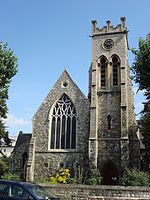Final edit of “The Colonel and the Vicar” should be ready soon. After that it’s off to the CreateSpace and Ingram self-publishing platforms, while at the same time the document goes to a small selection of “beta-readers”. There’s also the issue of the book cover, which I’ve been working on for over a month, and sad to say I’m running into copyright obstacles; nothing insurmountable, just looking for the best bang for my buck (Indie authors have to pay for everything). Still hoping to launch the book this April.
So why did I add the venerable Union Jack this time to the top of this post? I decided that this might be a good time to introduce a little more about my ancestral cousin, the Rev. Dr. Francis William Tremlett, or as I like to informally refer to him as, Father Frank, and the church that he founded in Belsize Park, a suburb of London.
Father Frank was an Anglican clergyman who grew up in the rough environment of the Newfoundland fisheries in the early nineteenth century. He eventually migrated to Boston but only spent a few years there. Father Frank was a no-nonsense guy, and he got into hot water when he tried to start a church in Boston without getting his bishop’s approval. After exchanging caustic letters, Father Frank left for Europe in the 1850’s to pursue further education. I have no doubt that living in Boston, the cradle of abolition, also had something to do with his leaving.
After receiving his first doctorate in 1852 from the University of Sachren in Germany, Father Frank was reunited with his wife Josephine, his mother Elizabeth, and sister Louisa in London whereupon he went about the business of establishing his church.
The construction and consecration of St. Peter’s was finished in 1859 and Father Frank received his incumbency in 1860. St. Peter’s today:
After that the vicarage was constructed, a grand edifice overlooking a garden that would serve as the vicar’s personal living space as well as for his family members, but would also accommodate the many “visitors” from the Confederacy. It came to be known as “Rebels’ Roost”, and together with other homes in the neighborhood provided everything from shelter to lavish entertainment for anyone connected to the Southern cause, from General Robert E. Lee to the common sailor.
Father Frank was a charismatic cleric, and as word spread of his preaching, his flock eventually crossed boundaries of the Victorian social classes, as among them were members of the aristocracy, the upper mercantile and middle classes, evangelicals, as well as orthodox parishioners. Church attendance grew so quickly that it quickly outstripped the capacity of St. Peter’s, and special galleries had to be constructed to accommodate the overflow.
During the early war years, as the South enjoyed victory after victory, Father Frank railed against the Union and tried to influence the British government to recognize the Confederate States of America as a new nation; later, when the fortunes of war turned against the South, beginning with Antietam and certainly in the wake of Gettysburg, the theme of his sermons emphasized ending the “fratricidal war in America”.
After the war Father Frank remained an “unreconstructed rebel”, and he helped raise funds to establish the University of The South at Sewanee, Tennessee, from which he received an honorary doctorate. As a further expression of gratitude, one of the first buildings erected there was Tremlett Hall, and there is a Tremlett Spring which still exists today.
Despite advancing age, Father Frank remained socially and politically active, forming the Institutes for Working Lads in 1899 (at age 80), a program for boys and young men having little or no means of financial support, by which they might apprentice to a trade and thereby improve their lot in life. Reverend Tremlett is also credited later in 1907 with establishing at his own cost and superintending a free hostel for men who wished to devote their lives to the ministry of the Anglican Church.
Father Frank lived long enough to celebrate his jubilee (50th anniversary) at St. Peter’s with an admiring congregation. He died “in harness”, having delivered his last sermon two weeks before his death on June 11, 1913 at the age of 92.
